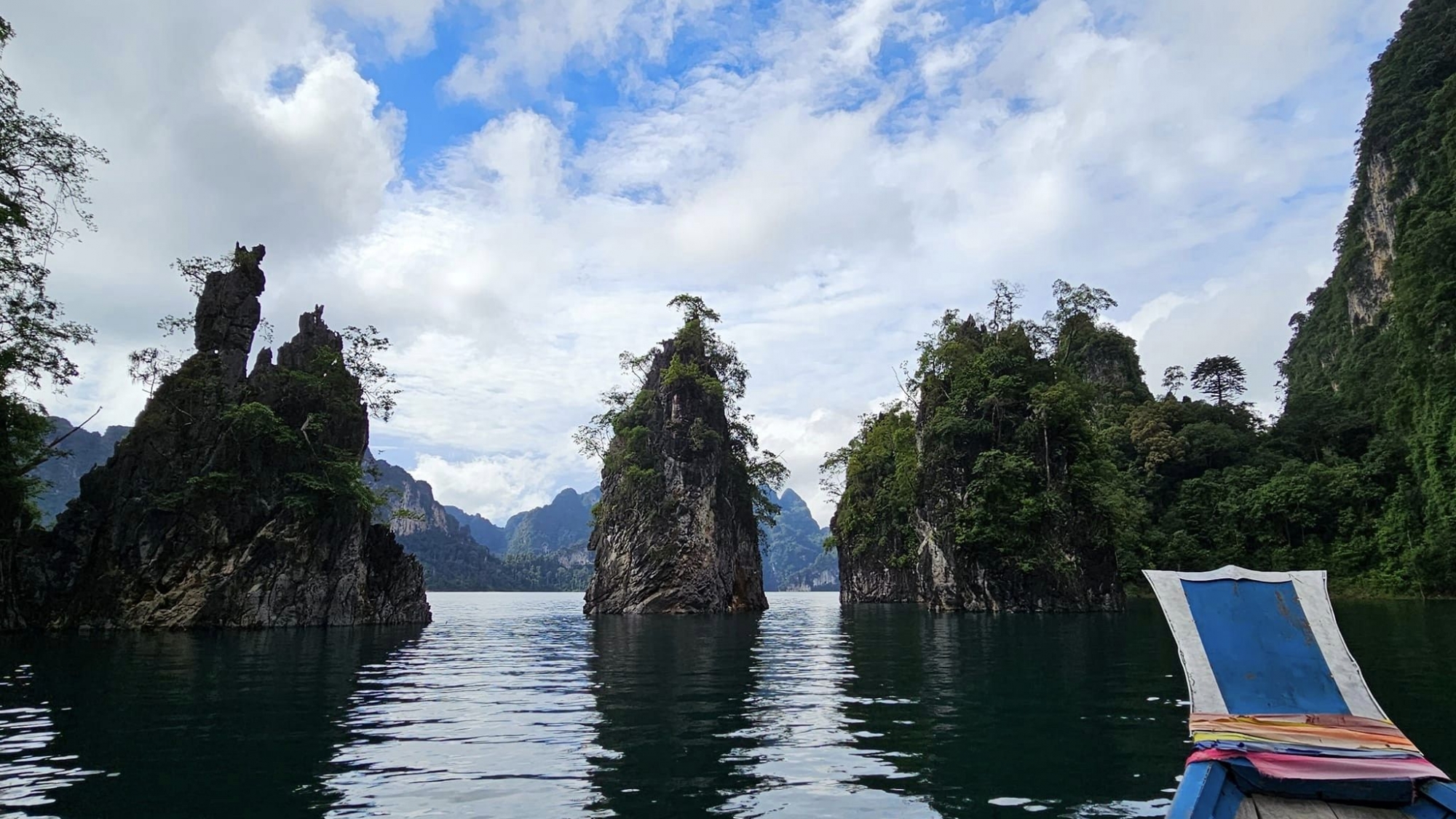Surat Thani, often shortened to Surat, is the largest of the southern provinces (changwat) of Thailand. It lies on the western shore of the Gulf of Thailand. Surat Thani means ‘city of good people’, a title given to the city by King Vajiravudh (Rama VI); Surat Thani is, therefore, the sole province in Southern Thailand for which the native name is in the Central Thai language.
Geography, Neighboring provinces are (from north, clockwise) Chumphon, Nakhon Si Thammarat, Krabi, Phang Nga, and Ranong.
Geographically, the center of the province is the coastal plain of the Tapi River, mostly grassland interspersed with rubber trees and coconut plantations. In the west are the limestone mountains of the Phuket range which are mostly covered with forest. Khao Sok National Park is found there. To the east, the hills of the Nakhon Si Thammarat (or Bantat) mountain range start to rise, protected in the Tai Rom Yen National Park. The total forest area is 3,764 km2 (1,453 sq mi) or 28.8 percent of the provincial area.
Many islands in the Gulf of Thailand belong to the district, including the tourist islands Ko Samui, Ko Pha Ngan, and Ko Tao, as well as the Ko Ang Thong Marine National Park.
The main rivers of Surat Thani province are the Tapi River and the Phum Duang River, which join at the town of Tha Kham shortly before they flow into Bandon Bay. The delta of these rivers, locally known as Nai Bang (ในบาง), is directly north of the city of Surat Thani. It consists of several channels with small islands mostly covered by mangroves and orchards.
History, The area of Surat Thani was already inhabited in prehistoric times by Semang and Malayan tribes. Founded in the 3rd century, the Srivijaya kingdom dominated the Malay Peninsula until the 13th century. The city of Chaiya contains ruins from the Srivijaya period, and it was probably the regional capital of the kingdom. Some Thai historians even argue that it was the kingdom’s capital for a time, but this is disputed. Wiang Sa was another important settlement of the time.
Wat Kaew in Chaiya, dating from Srivijavan times.
After the fall of the Srivijaya, the area was divided into the cities (mueang) of Chaiya, Thatong (now Kanchanadit), and Khirirat Nikhom. Chaiya was administered directly from the Thai capital, while Thatong and Khirirat were controlled by the Nakhon Si Thammarat Kingdom. In 1899, they were all merged into a single province called Chaiya. In 1915, the court of the Monthon Chumphon was transferred to Bandon, which received the new name of Surat Thani on 29 July 1915, during a visit of King Vajiravudh (Rama VI). This was likely influenced by the major port city of Surat in Gujarat, India. The month on was also renamed Surat. In 1926 it was abolished and incorporated into monthon Nakhon Si Thammarat. The monthon was dissolved in 1933, and the province became a first-level administrative subdivision.
Javanese or Sailendra-style pagoda, Chaiya.
The provincial administration was in a building in Tha Kham (Phunphin District). Shortly before World War II, it was moved to the city of Surat Thani, on the banks of the Tapi River, which is named after the Tapi River in Surat, located in southern Gujarat, India. When the Japanese invaded Thailand on 8 December 1941, the administrative building was destroyed during the battle for the city. It was rebuilt in 1954, but on 19 March 1982, a bomb planted by communist rebels blew up the building, killing five people. The third and present building was relocated to the south of the city, and the former site of the provincial hall is now the site of the city pillar shrine (Lak Mueang).
Symbols, The seal of the province shows the pagoda of Wat Phra Borommathat Chaiya, which is believed to have been built 1,200 years ago.[8] The flag of the province shows the pagoda in the middle, placed on a horizontally split flag with orange on top and yellow on the bottom.
The provincial flower is the bua phut (Rafflesia kerrii), a parasitic plant with one of the biggest flowers of all plants. The provincial tree is the ton kiam (Cotylelobium melanoxylon).
The provincial slogan is “เมืองร้อยเกาะ เงาะอร่อย หอยใหญ่ ไข่แดง แหล่งธรรมะ” (Mueang roi ko, ngo aroi, hoi yai, khai daeng, laeng thamma), which translates to “city of 100 islands, delicious rambutan, big shells, red eggs, the center of Buddhism”. “Red eggs” refers to a local culinary specialty of salted duck egg, while the “big shells” refers to the abundant oyster available. “Center of Buddhism” refers to the Wat Phra Borommathat Chaiya and Suan Mokkhaphalaram.
Thing to do in 3 Days 2 Nights
Rajjaprabha Dam, Formerly named Chiao Lan, Rajjaprabha Damis situated in Tambon Khao Phang, Amphoe Ban Ta Khun, Surat Thani. The Dam was officially opened on 30 September 1987, together with the hydropower plant, which was inaugurated by King Rama IX, who granted the name “Rajjaprabha” meaning the “Light of the Kingdom” in conjunction with the purpose of generating electricity.
With breathtaking scenery inside the Reservoir or so-called Chiao Lan Lake comprising a range of undulating limestone mountains emerging from the emerald sea and indigo blue sky with the mist occasionally drifting along the mountaintops, the Dam can offer a wide range of activities within the Lake; such as, sightseeing by Boat, staying overnight on rafts, kayaking, spotting animals, etc. It can be said that this dam has become a once-in-a-lifetime destination for tourists and the number one attraction in mainland Surat Thani province.
For Accommodation at the Electricity Generating Authority of Thailand (EGAT), please contact Tel. 0 7731 0780, the Chiao Lan Municipality Pier at Tel. 08 3300 1730, and the Tourism Association of Chiao Lan Lake at Tel. 08 9724 1475.
Khao Sok National Park, Is one of the most abundant tropical rainforests in Thailand. The Park hasa diversity of ecosystems and wildlife varieties, especially, conserved wild animals; such as, marbled cat, Malayan tapir, Fea’s muntjac, serow, as well as rare and nearly extinct birds like Hooded Pitta, and Malayan Banded Pitta. It is also a habitat of endemic rare plants; such as, White elephant palm, Maxburretiafurtadoana, and Rafflesiakerrii – a parasite plant of which its flower has a large diameter of about 70-80 centimeters.
The Park is a center of tourism connectivity between the Gulf of Thailand and AnDaman sea and a Destination for trekkers around the world. Many of them fall in love with this forest and keep coming back. Besides Trekking, there are other exciting activities to do; such as, Canal tubing in Khlong Sok, kayaking, and elephant riding. One of the fascinating pointshereis a tree housebuilt for Accommodation that is available in many places. Allof them are located amidst the rainforest.
For more inquiries, please contact the Khao Sok national park’s headquarters, Tambon Khlong Sok, AmphoePhanom, Surat Thani, Tel. 0 7739 5139, and 0 7739 5154 – 5, facebook: KhaosokNP
Khao Na NiLuang Dhamma Park, Khao Na Nailuang Dhamma Park, located in Tambon Thon Yuan, AmphoePhanom, Surat Thani, was founded by a monk, PhraAchanPhrai. He and the Villagers joined forces to build the stupa on the top of limestone terrain engulfed by pleasant nature. In the morning, a sea of mist will appear around the area that gives a feeling like watching the stupa floating in the sky. The Local people who have free time will volunteer to help build the stupas with the goal to have seven stupas in total of which each stupa will have a different name and architectural style. To learn more information, please call Tel. 09 5017 8259, 06 2873 7135.
Phrathat Si Surat, built in 1957 on the top of KhaoThaPhet, 6 kilometers southwards from downtown, Phrathat Si Surat is the first sacred place of the district which features a tall shape like a big candle or the Pillar of Ashoka decorated with stucco designs. This stupa is considered to be the outstanding adapted Srivijaya architecture. On 27 March 1959, during the visit to Surat Thani, King Rama IX and Queen Sirikit paid homage to the stupa and planted Phayom (Shorearoxburghii) trees for auspiciousness. Later in 1984, HRH. Princess Sirindhorn came to visit and performed a ceremony of installing the Buddha’s relics and planted Khiam or Cotylelobiumlanceolatum, the provincial tree of Surat Thani. Hence, Khao Tha Phet is a Historical and auspicious place for the Local people. For this reason, the HaePhaHomPhrathat Si Surat LaeThammachat Khao ThaPhetFair is annually held from 26-27 March to honor King Rama IX and express loyalty as well as to give recognition of this sacred place amid its abundant nature. The parade of Phrathat wrapping Cloth is to illustrate a belief in Buddhism, which resembles the robe offerings to the Lord Buddha. For more inquiries, please call Tel. 08 9872 9732, 0 7727 2058.
Ban Phumriang Community, Is an old community that has carried the legacy of the Phumriang port and trading center since the prosperityof the Srivijayaera. It is home to Thai-Buddhists and Thai-Muslims who live together in harmony and is also a renowned source of Phumriang silk Fabric, hometown of Buddhadasa Bhikkhu, an acclaimed monk, and seafood source. Visitors will learn the martial art, MuayChaiya, observe the blue swimmer crabs’ bank, try Khanom Bok, KhaiMok, or visit ko Set, an Island wherethe beacharea of 1,000 rai will emerge once a year, or seek an endemic shellfish, called Sap Khet that tastes so sweet, baby clams and lamp shells. The activities also include catching mullet with a trawl and bringing them back to the Village for cooking and eating on the shelter along the sea breeze by Khlong Phumriang.
Chaiya salted eggs (Surat Thani), or salty eggs from Surat Thani’s Chaiya district are famed for their distinctly red yolks and having the right balance of saltiness. ไข่เค็ม /kài kem/ are traditionally made with duck eggs because they are slightly larger than chicken eggs, and have a bigger yolk


